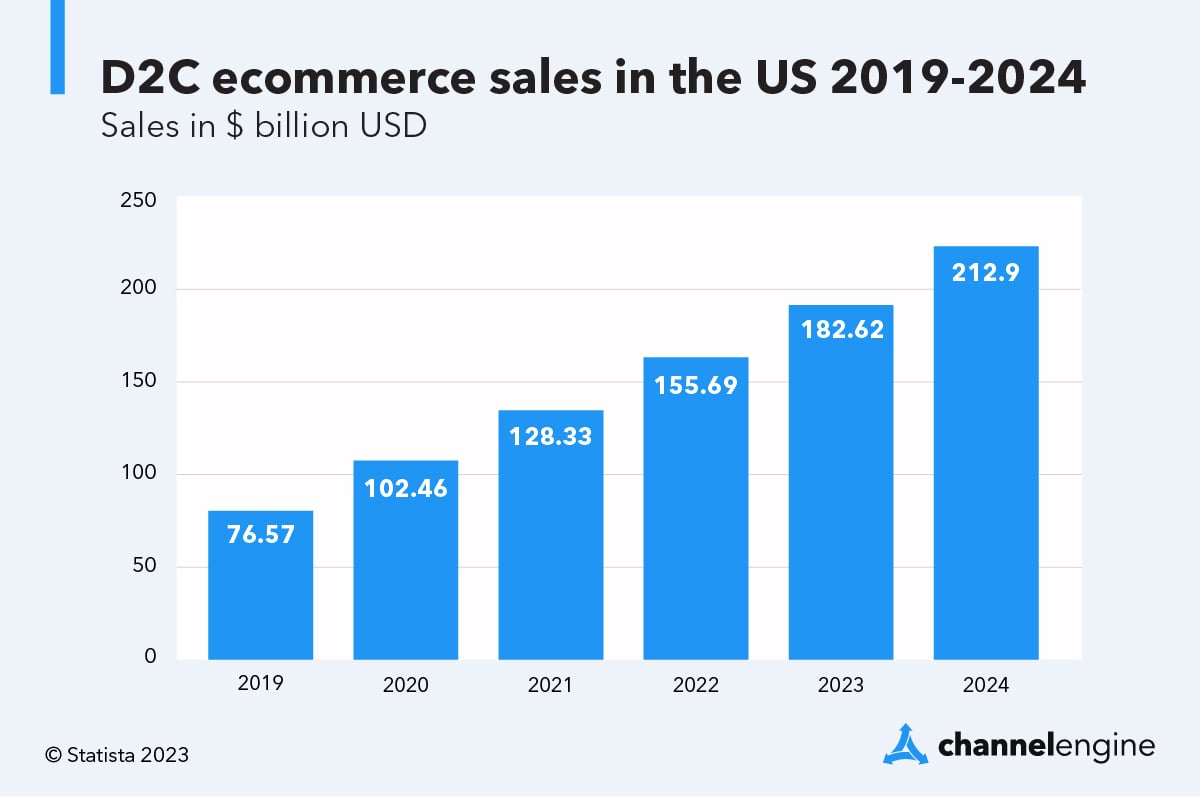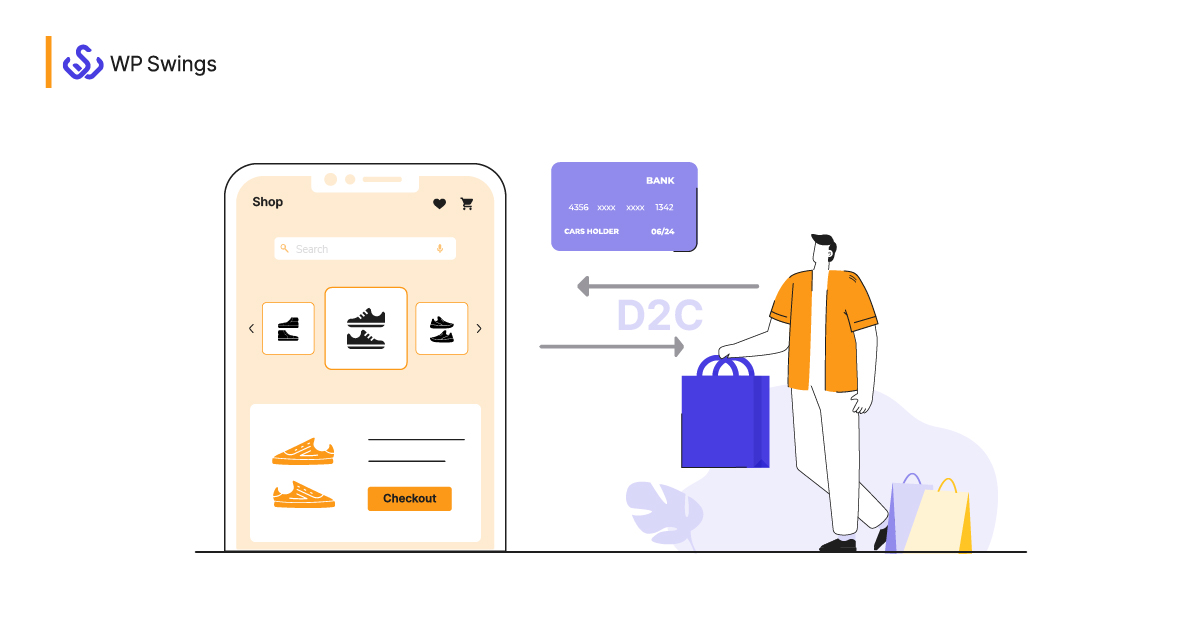Discovering the Possible of D2C Ecommerce: A Comprehensive Overview for Companies
The D2C ecommerce design offers a considerable change in how brands engage with customers. It makes it possible for firms to bypass traditional retail networks, promoting deeper connections and possibly boosted profit margins. Nonetheless, this method is not without its complexities. Recognizing the nuances of D2C ecommerce is necessary for brand names intending to flourish. What techniques can they take on to navigate this developing landscape successfully? The solutions might redefine their organization approaches.
Comprehending the D2C Ecommerce Model

Secret Advantages of D2C Ecommerce for Brands
The D2C ecommerce version provides brand names significant benefits, specifically regarding enhanced earnings margins. By removing intermediaries, companies can retain a larger share of sales revenue. In addition, this straight partnership with customers cultivates boosted brand name loyalty, motivating repeat purchases and long-term involvement.
Raised Profit Margins

Improved Brand Name Commitment
Structure on the economic benefits of D2C ecommerce, boosted brand loyalty becomes another important benefit for firms engaging directly with customers. By establishing a straight connection, brands can foster much deeper connections with their customers, acquiring insights right into habits and preferences. This straight interaction enables more personalized marketing strategies, which reverberate highly with customers. Additionally, brand names have the opportunity to regulate their messaging and customer experience, enhancing brand name values and constructing depend on. When clients really feel an individual connection, they are extra most likely to return, advocate for the brand name, and participate in area involvement. Inevitably, boosted brand name commitment not only drives repeat acquisitions yet also grows a passionate customer base, more strengthening a brand's position in the marketplace.
Challenges Faced by D2C Brands
D2C brand names run into numerous significant difficulties that can influence their success. Stock management issues can bring about stock lacks or excess, complicating procedures and consumer contentment. Additionally, marketing spending plan restrictions usually limit the ability to effectively reach and involve target market.
Inventory Management Issues
Efficient inventory administration provides an awesome obstacle for lots of brands running in the direct-to-consumer (D2C) area. These brand names commonly face changing need, which can cause overstock or stockouts, eventually affecting customer complete satisfaction and profits. In addition, the absence of advanced stock tracking systems can cause discrepancies in between real supply degrees and reported data, making complex order gratification. The diverse variety of products D2C brands generally use additionally complicates supply monitoring, as variants in styles, shades, and dimensions require even more thorough oversight. Furthermore, many D2C businesses may battle with restricted warehousing abilities, causing inefficient use space and resources. Reliable stock monitoring stays a vital hurdle for D2C brand names aiming for sustainable development and operational efficiency.
Marketing Budget Plan Constraints
Steering advertising and marketing budget restrictions is a substantial obstacle for lots of direct-to-consumer (D2C) brand names. Minimal monetary sources frequently restrict these companies' capacity to spend in comprehensive advertising and marketing approaches, resulting in minimized presence in an affordable market. D2C brand names regularly come to grips with the requirement to optimize return on financial investment (ROI) while targeting specific audiences efficiently. This obstacle is aggravated by rising expenses in digital marketing and the necessity to designate funds throughout multiple channels, consisting of social media sites, online search engine, and email advertising. Numerous D2C brand names should introduce cost-effective marketing services, leveraging natural development approaches and influencer collaborations. Inevitably, efficiently steering these budget constraints is vital for sustaining development and accomplishing long-term profitability in the evolving ecommerce landscape.
Techniques for Constructing an Effective D2C Ecommerce Business
As consumers progressively look for straight links with brands, establishing a successful D2C ecommerce company calls for a calculated strategy that prioritizes consumer interaction and count on. One effective technique is to produce compelling brand narratives that reverberate with target audiences, promoting emotional connections. Using social media platforms can improve presence and help with two-way communication, permitting brands to engage directly with customers.Moreover, individualized experiences with tailored advertising and marketing initiatives can considerably boost client retention and loyalty. Implementing loyalty programs and using exclusive offers can additionally incentivize repeat purchases.Streamlining the acquiring procedure is important, ensuring a straightforward interface that boosts the purchasing experience. In addition, transparent interaction pertaining to shipping and returns builds trust fund and urges customer confidence.Finally, proactively seeking consumer feedback and responding to it shows a commitment to renovation and customer contentment, important aspects in the affordable D2C landscape.
Leveraging Modern Technology for Boosted Consumer Experience
In today's competitive D2C ecommerce landscape, modern technology plays a pivotal duty fit customer experiences. Companies increasingly use advanced tools such as artificial knowledge, chatbots, and individualized algorithms to enhance interactions and simplify the shopping procedure. By integrating these innovations, brands can give customized product recommendations based on private preferences and purchasing behaviors, cultivating an extra interesting experience.Moreover, receptive web site designs and mobile applications ensure that consumers can access services flawlessly throughout various gadgets. Enhanced repayment options, consisting of one-click check outs and electronic pocketbooks, better simplify deals, making it less complicated for consumers to make purchases.Data analytics additionally makes it possible for companies to gather understandings into client behavior, permitting continuous renovation of offerings and solutions. Overall, leveraging innovation not just enhances customer satisfaction but also cultivates loyalty, eventually driving lasting success in the D2C ecommerce industry.
Advertising And Marketing Tips to Drive D2C Sales
Exactly how can brand names properly catch the focus of customers in a saturated market? To flourish in the direct-to-consumer (D2C) landscape, brands must use targeted advertising and marketing techniques. Making use of social networks systems, brands can involve customers with interactive content, influencer collaborations, and user-generated blog posts. Customized email projects can also cultivate a feeling of connection, supplying customized promos based on customer actions and preferences.Moreover, narration plays an important duty in separating a brand's story, making it memorable and relatable. Brand names should buy search engine optimization (SEO) to boost visibility, guaranteeing their products are conveniently visible online. Furthermore, leveraging data analytics enables organizations to fine-tune their advertising methods and understand customer patterns much better. Inevitably, a multi-channel method that integrates creative thinking with data-driven insights can greatly boost D2C sales, permitting brand names to stand out in a congested market.
Future Patterns in D2C Ecommerce
With the quick evolution of technology and consumer preferences, the future of D2C ecommerce is poised for considerable improvement. Emerging trends suggest a shift towards hyper-personalization, where brand names utilize data analytics to customize offerings to private consumer needs. This modification boosts client experiences, promoting commitment and engagement.Moreover, sustainability is coming to be a necessary element, with customers significantly preferring brand names that focus on environment-friendly methods - D2C Ecommerce Agency. Firms are expected to adopt transparent supply chains and lasting materials to meet this demand.The combination of expert system and augmented reality will in addition transform the shopping experience, allowing consumers to imagine items in their atmospheres before purchase. On top of that, social business is anticipated to grow, as platforms more info like Instagram and TikTok promote seamless purchasing experiences directly within social media.These fads collectively represent a dynamic future for D2C ecommerce, emphasizing customer-centric strategies and innovative technologies that redefine customer interactions
Often Asked Inquiries
What Industries Benefit Many From D2C Ecommerce?
The existing concern highlights markets that thrive with direct-to-consumer (D2C) ecommerce. Incredibly, style, charm, electronics, and food industries utilize D2C designs to enhance brand commitment, boost customer relationships, and enhance revenue margins efficiently.
Just How Do Delivering Expenses Influence D2C Rates Strategies?
Delivering prices significantly influence D2C pricing techniques. Businesses need to balance these expenditures with competitive rates, taking into consideration consumer assumptions and revenue margins. Efficient management of shipping can improve customer contentment and drive sales in direct-to-consumer models.
What Payment Options Should D2C Companies Deal?
D2C businesses need to supply diverse payment choices, consisting of credit/debit cards, digital purses, and purchase currently, pay later services. This range improves customer comfort, increases conversion rates, and provides to various consumer preferences in the online buying landscape.
Just How Can D2C Brands Deal With Client Returns Effectively?
D2C brands can take care of consumer returns efficiently by carrying out user-friendly return plans, providing pre paid shipping tags, and guaranteeing timely refunds (D2C Ecommerce Agency). Clear communication and streamlined procedures enhance customer fulfillment and urge repeat company
What Lawful Considerations Exist for D2C Ecommerce Procedures?
Legal considerations for D2C ecommerce procedures include conformity with consumer security regulations, information personal privacy regulations, intellectual property rights, and tax demands. Brands should navigate these intricacies to prevent legal mistakes and guarantee smooth operations. By removing intermediaries, D2C brand names can supply competitive pricing and promote a more intimate connection with their customers.The D2C design is defined by its dependence on digital systems, making it possible for brand names to use social media, on the internet markets, and their very own internet sites to engage with customers directly. D2C ecommerce facilitates the collection of beneficial client data, making it possible for brand names to customize their offerings and advertising strategies efficiently, ultimately driving sales and boosting margins. In addition, brand names have the opportunity to control their messaging and client experience, enhancing brand values and building count on. As consumers increasingly look for direct links with brand names, developing an effective D2C ecommerce company calls for a critical strategy that prioritizes consumer engagement and depend on. D2C brands can take care of consumer returns effectively by executing straightforward return policies, offering prepaid shipping tags, and guaranteeing timely refunds.